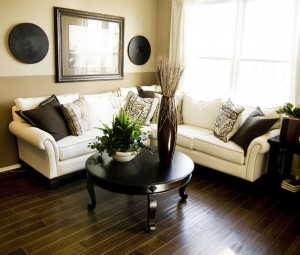Home Design Trends your Brain is Pulling you Toward
The home decorating industry is growing in a time when many other industries are cutting back.
Technology Finds a Home in Home Design Trends
Technology, CNN Money says is playing a huge role in that growth—from Nest thermostat, which learns what temperatures we prefer and adjusts itself accordingly—to Edge Home, which gives you a monthly breakdown of the energy use in your home down to individual outlets and switches.
Hidden panel dishwashers, the article says, are the wave of the future, but often with the ultra-silent settings, it is impossible to tell if the machine is turned on, let alone how long you have left in the cycle.
And Corian is developing a counter with hotspots that will charge your phone when you put it down so you never have to let it out of your sight.

Luxury Is Still in, but In a More Unique Way
Luxury is also a big home design trend this year. Before the recession, the perception of luxury was linked to square footage, vaulted ceilings or granite counter top. Today’s definition of luxury has evolved into something that’s more accessible.
You can see the trend in the National Association of Home Builders (NAHB) and Hanley Wood’s annual flagship show house, The New American Home, the article says. Even at 6,700 square feet, the house offers take-home advice for all budgets.
This multimillion dollar home includes stock kitchen cabinets, floor tiles and lighting systems all inventively made to look custom-made. The layout is open and airy incorporating outside elements into the interior. Going further, the open yet clearly defined rooms of the New American Home are differentiated with off-the-shelf millwork to create textured accent walls, something often seen on HGTV and something anyone can achieve as a DIY project.
Darker kitchen cabinets or countertops are transitioning to lighter colors. And double-height entries and great rooms are being replaced with more intimate nine- and 10-foot ceilings.
Jill Waage, editorial director at Better Home and Gardens, sees this trend especially among millennials, who are beginning to make their mark on home design.
Inspired by sites like Pinterest, Waage sees this younger set adding more personal touches to their homes by combining vintage and contemporary furniture, installing creative storage and also adding unique lighting and attention-grabbing wallpaper.

Going Green
In a recent survey conducted by the NAHB, approximately 70% of consumers acknowledged that while they were concerned with the environment and wanted an environmentally friendly home, they did not want to fork over the money for the extra cost. In the same survey, over 80% of consumers felt that it is important to have an energy efficient home and would pay between $6,774 and $9,146 to lower their energy bills. In other words, the same question posed in two different ways on the same survey resulted in opposite answers drawing us to the conclusion that people are torn on the subject.
As this trend continues and companies can illustrate tangible benefits for customers, more homes will become more efficient.
As the economy continues to rebound, it will be interesting to see what trends remain on the top of homeowner’s checklists, which ones vanish into oblivion and what new ones designers can come up with.


